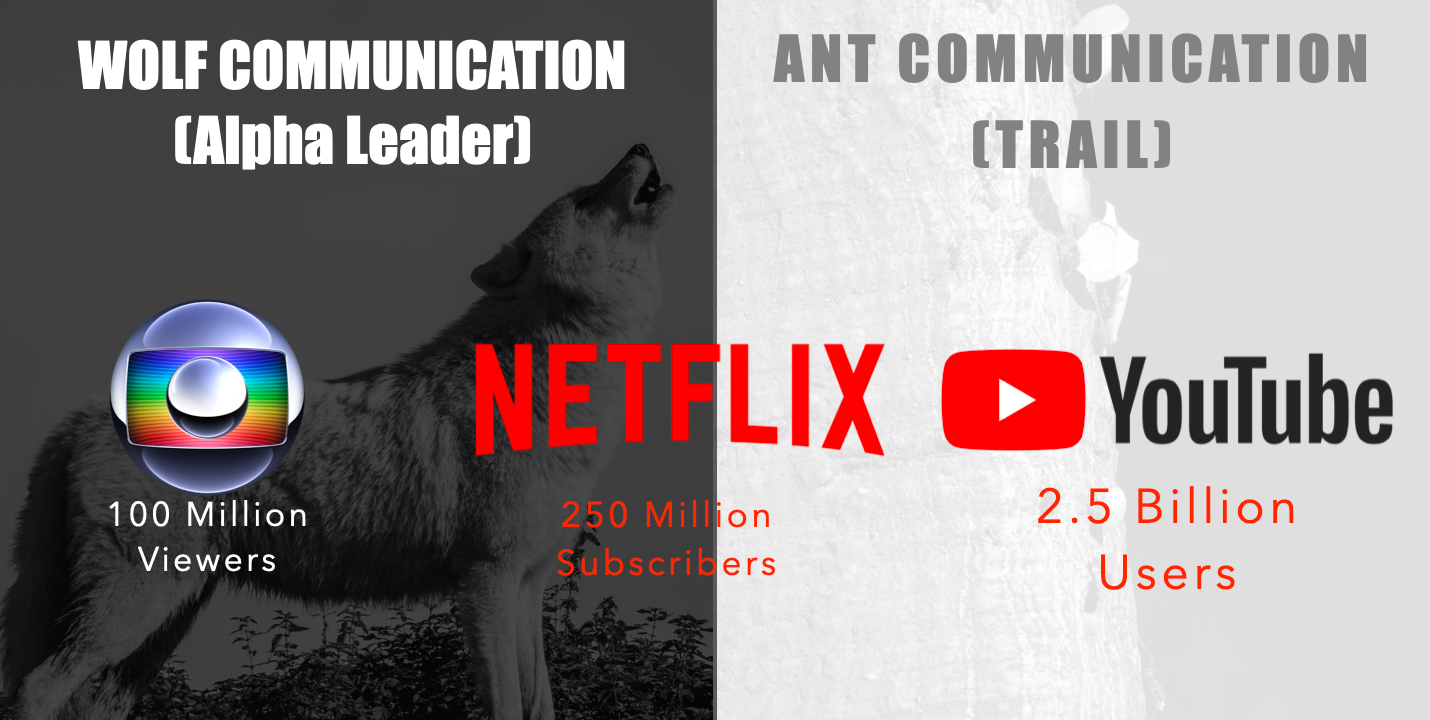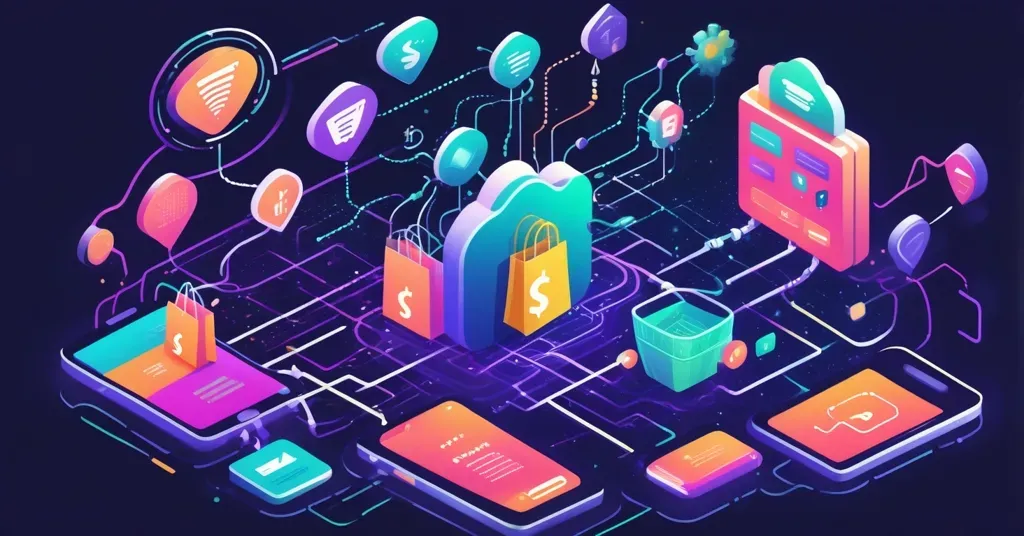
Wolves to Ants: The Winning Strategy for the Digital Age
We are changing our communications system and that has a huge impact on businesses. Understand how you can navigate this new management era.
Check this crazy news laid out during the World Cup 2022:
- Globo Communications, Brazil’s Media Giant, suffered severe losses from broadcasting the World Cup
- Disney was changing its CEO due to losses reported all over the company
- A few months earlier, Netflix was struggling and creating new revenue streams through Ads
On the other hand:
- Casimiro, Brazil’s biggest digital influencer, hit the YouTube World Record for a Live Stream (6Million devices simultaneously) when airing Brazil’s Quarter-final Match against Croatia.
What is going on here?
Let’s dive deep into what that means for you and your company’s future. And no, you don’t have to become a YouTuber. But yes, you have to adapt.
The Medium is (still) the Message
When McLuhan shared this quote for the first time, he realized that the behavior of families in the US was changing due to the television. His concept was that once you change how we communicate, society changes; hence “The Medium is the Message.”
With time, most of the focus of study on social change shifted towards MacroTechnology changes, especially influenced by The Third Wave by Alvin Toffler. But where do technological shifts come from?
If you guessed information exchange empowered by the new medium, you got that right. Let’s check three examples from the Three Waves:
- Before Agricultural Revolution, there was Written Communication;
- Before Industrial Revolution, there was Gutenberg’s Press;
- For the Digital Revolution to happen, came the computer and with it, the internet, which is the foundational medium of the Third Wave.
Characteristics of Media Change
There’s a loop chain reaction related to this medium change:
- First, there’s an increase in the abundance of information;
- Then, there’s an increase in the storage of information;
- Thirdly, there’s a reduction of the friction layers to access information, meaning democratization;
- Finally, this loop from 1 to 3, leads primarily to societal revolutions, which, in the end, leads to hierarchical changes.
Gutenberg’s press is the easiest and closest example we have to study from; right afterward, society experienced Protestant Reform and Scientific Revolution, which drove Industrial Revolution and the French and American Revolutions. Kings were dethroned, great institutions fell to their knees, and new management models emerged.
That’s exactly where we are with the Digital Revolution.
From Wolves To Ants

Wolves are amazing, they move in packs, have a clear hierarchy and communication model, and we use their leadership style as an inspiration for us.
Ants are amazing too. They store food in the summer to prepare for the winter and create massive civilizations. The biggest difference, though: is that they don’t have a Leader, which led them to create a different communication system, a trail-based communication.

And that’s what this essay is about. The image below clarifies the differences between these two management models and our current tech availability:

What’s amazing is that it’s the first time in history that we have the tools that can allow us to move toward Leaderless management (Rita Mcgrath has called it a Permissionless structure). Once again, media change is causing shockwaves all over the place.
The Upload Generation
The biggest change unleashed by the Digital Revolution is UGX (User-generated Anything). We can UPLOAD anything we want to the cloud, from products on Amazon’s Marketplace to rides on Uber to Content on social media.
The lack of curation, or better, an algorithmic-based curation has an amazing upside, we now had a voice and didn’t need to rely on Big Companies/Media/Retailers to tell us what we should consume. From Wolves to Ants. Talents emerged from anywhere, expensive products became democratized, and we can now deeply connect with local cultures through Airbnb stays. Chris Anderson called this effect the Long Tail.

It’s from that management change, this new UPLOAD behavior, that people like Casimiro were born. It doesn’t stop with him or other content creators like Mr. Beast, it’s a new generational cornerstone. They expect to be “ants,” building their colony and leaving a trail for the ones coming.

What this chart tells us is that soon there won’t be pre-digital customers. Meaning our businesses have just a few decades at best to get redesigned. This new generation is growing in the Upload Age and won’t be willing to relate with brands that don’t give them a space for co-creation.
If that’s not enough of an argument, here’s the case for why you should move toward an Ant-like management model:

As you can imagine, Globo has complete control of everything that goes in it. They own studios, directors, actors, and writers. Their editors decide what goes on-screen every second.
Netflix, on the other hand, works mostly with capital deployment. They don’t own most things, but their editors decide which content to invest in and show on their platform.
YouTube allows “ants” to Upload whatever they want, and the other “ants”, through the trail-based communication model, decide what’s good or not.
But you see, it’s not just a difference between having a Digital Presence (like Globo does very well). It’s a move toward a platform business model that is completely different from traditional.
What should one do then?
A few years ago, I had the chance to visit Bauhaus, the German school that is considered the birth of design. One of the most remarkable stories I heard was that of Marcel Breuer.
He was a pretty average student who didn’t fit well into the first few months of the course, where students experienced different raw materials. Until he got his hands on the Tubular Steel and built a very minimalistic chair that was later named after one of his teachers who greatly admired the work. The Wassily chair was born, one of the most iconic pieces of furniture.

I hope you get the point that we don’t know who is the next Breuer, and hardly any furniture manufacturer would get to that design. What led Breuer to be able to design such a timeless piece was Bauhaus’s unique curriculum that pushed students to become Co-creators of Value with their teachers and classmates. The school was a platform to foster creativity. Students weren’t “downloaders” of knowledge but “uploaders” of ideas.
During the launch of the original iPhone in 2007, Steve Jobs gave us a masterclass on what causes disruption. After his 5-minute initial pitch, he continues his presentation by explaining that disruption comes from Revolutionary User Interfaces and that Multi-touch would be the disruptor of cell phones. It was indeed, but there was another lever that made the iPhone transform our lives, the App Store 6 months later.
It became the hallmark of the Platform business model that would redefine our economy in the last decade. Although many people criticize the hefty chunk they take as commissions using the term “creativity toll,” it’s good to remember that they created the road that paves digital creativity.
So, following those examples, here are three tips for your business to harness the power of this Ant-like transformative management model and Revolutionize the UI of your business.
1. The Share Button
Let’s start with the easy one. If you go to your web browser and access Netflix, there’s no way to share any movie with anyone, unless you copy+paste the link on your browser’s bar. You can only find that option on the mobile app, but it still directs you toward other apps. It doesn’t foster community building inside the platform.
Perceive that some UI nuances hide deeply embedded mental and management models behind them. A UI is much bigger than what the eye sees. If you do the same exercise on Prime Video, you’ll see that the Share Button is easily apparent on any device, and you’ll also find a WatchParty button. A community-fostering UI tweak that proves the point! Amazon is the most experienced in creating platform business models compared to all its competitors. And although Netflix is great, it has no history of how to navigate this ant-like space.

Amazon's Watch Party is a great example of a Community & Crowd attribute from ExOs and a great one to be followed by companies looking to not only accelerate through digital but also begin its core transformation.
2. Co-creation > Personalization
It’s cool to see that Netflix recommendations are personalized for you, meaning they are different from your spouses or kids for example.
It’s nice that I can go to Globoplay and choose which cartoon to watch with my 1-year-old at any given moment.
But it’s even cooler to Upload her videos swimming, buy a handmade toy from an artisan far away, or offer our room to another family so our kids can meet.
That’s the difference between watching the World Cup from Globo, where everything fits a “Wolf-defined” script vs Casimiro’s broadcast. People were talking to him in real-time, and his whole content creation is co-creation. The more a spark of an idea grows within his community, the biggest the chance for a new solution emerges. The “ants” define the script, in this case. But it could be a new product, a new service, or whatever.
In terms of UI, that means you must have an Upload (+) Button. Otherwise, you are just moving your current model into digital instead of becoming a platform for creativity like Bauhaus was. Now, don’t think that it’s just a + button anywhere on the screen. It’s a whole new business model behind that button that needs to be thoroughly thought out.

Analyze any competitive landscape in the digital space, and you’ll see that winners foster their communities through initiatives such as template building, plugins, and app stores. That’s why Adobe paid $20B for newcomer Figma. Why Evernote lost the battle to Notion? Why Salesforce became the largest enterprise software surpassing SAP? Or why iOS and later Android, disrupted Windows Mobile.
3. Internal UI overhaul
We’ve talked a lot about User-oriented Interfaces, the ones we create for the external ecosystem around your business. But business model changes are cultural changes. Don’t expect any digital leader to behave as digital laggards. This means you need to create internal interfaces that promote the upload movement inside the company. A place of experimentation and psychological safety, as Marcel Breuer found at Bauhaus.
There are many methods and practices available for you to get inspiration from, whether it’s Amazon’s Working Backwards and 6-page models, Double Diamond workshops, to our own ExO Sprint model.
For those who are just starting, after over 130 projects ran in 13 countries I’m a huge proponent of giving your first steps with Design Sprints (something similar to the book by Google, but not limited by it). It’s a fast-paced process, in a safe environment, with loads of “uploads” from different stakeholders that end with a lot of experimentation.
Gradually, then suddenly
In the end, there’s no sugarcoating this moment, it’s probably the biggest transformation in Management EVER. The Leaders of the Digital Age all share this same trait. And your future customers expect to work with companies that have embraced it.
Of course, you can decide that this route doesn’t fit you or your company, and choose to spend the next few years embracing hyped technologies to accelerate business as usual. Just don’t forget that The Medium is Still the Message, and the new message is now delivered through a trail-based system like ants.

ExO Insight Newsletter
Join the newsletter to receive the latest updates in your inbox.









